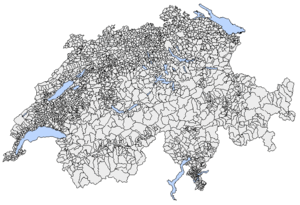Municipalities of Switzerland

Municipalities (sometimes called communities or communes, after the French/Italian names) are the smallest government division in Switzerland, and are called Gemeinden in German, communes in French, comuni in Italian and vischnancas in Romansh. As of January 2006, Switzerland has 2740 municipalities.[1] While many have a population of a few hundred citizens, the largest cities such as Zürich or Geneva also have the legal status of municipalities. The area of the municipalities varies between 0.28 km² (Ponte Tresa, Ticino) and 282 km² (Bagnes, Valais).
Each canton defines their responsibilities. These may include providing local government services such as education, medical and social services, public transportation, and tax collection. The degree of centralization varies from one canton to another.
Municipalities are generally governed by a council headed by a mayor as executive and the town meeting as legislature. Most cantons leave the option to larger municipalities to opt for a city parliament. In some cantons, foreign persons that have dwelled for a certain time in Switzerland are also allowed to participate in the municipal politics.
Swiss citizenship is based on the citizenship of a municipality. Every Swiss is citizen of one or several municipalities (i.e. the place of origin, lieu d'origine, Heimatort).
Municipalities are financed through direct taxes (e.g. income tax), with rates varying more or less within a framework set by the canton.
Many municipalities are having difficulties maintaining the civil services they need to perform the duties they are required to do. In an effort to reduce expenses, many municipalities are combining together (through mergers or the creation of special-purpose districts). This restructuring is generally encouraged by the cantonal governments and the rate of these unions is increasing.
"Cities" (villes or Städte) are the municipalities with more than 10'000 inhabitants or smaller places which had medieval town rights. There is no specific designation for smaller municipalities ("villages", "towns").
| Population | Number of municipalities (%)[2] |
| >20,000 | 30 (1.1%) |
| 10,000–19,999 | 89 (3.2%) |
| 5000–9999 | 180 (6.6%) |
| 1000–4999 | 1025 (37.4%) |
| 500–999 | 555 (20.3%) |
| <500 | 861 (31.4%) |
| Total | 2740 (100%) |
Municipalities are numbered by the Swiss Federal Office for Statistics (see Community Identification Number#Switzerland). One or more postal codes (PLZ/NPA) can by assigned to a municipality or shared with other municipalities.
See also: List of cities in Switzerland
Contents |
Lists of municipalities by canton
|
|
See cantons of Switzerland for the number of municipalities per canton.
List of municipalities by population
|
|
nb. Corippo has now taken place as smallest city/municipality in Switzerland with only 17 inhabitants. (2004 Census)
See also
- List of municipalities of Switzerland
- List of twin towns and sister cities in Switzerland
- Former municipalities of Switzerland